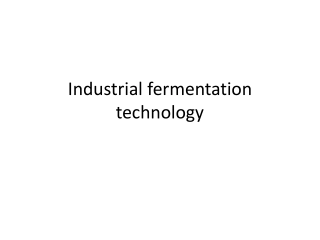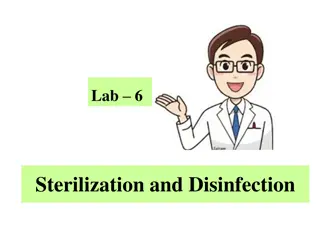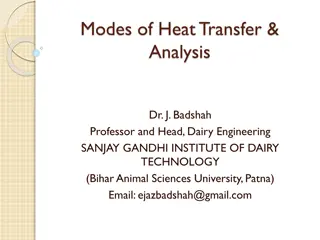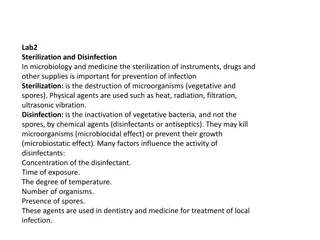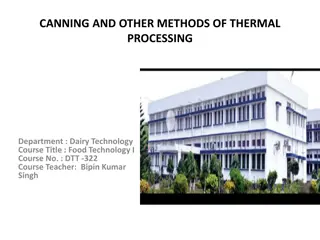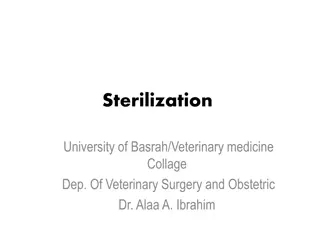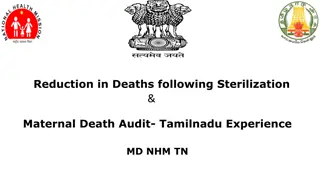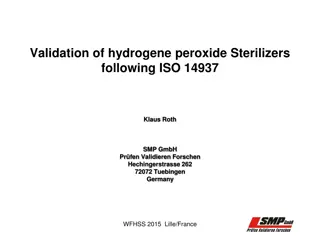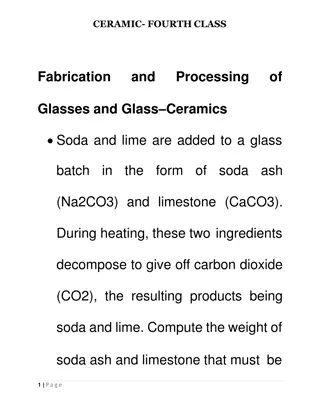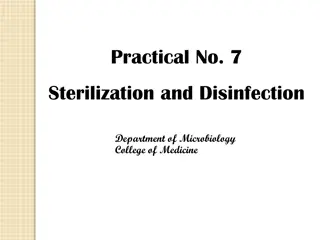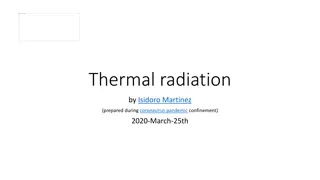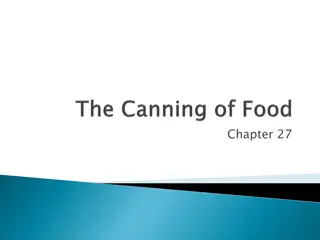Understanding Thermal Processing and Sterilization in Canning Operations
Thermal processing in canning operations involves heating sealed cans to specific time-temperature schedules to ensure consumer safety, prevent spoilage, and maintain product quality. While complete sterility is not the goal, commercial sterility is achieved to eliminate harmful microorganisms. The process aims to render the food free from viable forms of microorganisms that could reproduce under non-refrigerated conditions. Proper sterilization is crucial to prevent the growth of bacteria like Clostridium botulinum in canned fish products.
Download Presentation

Please find below an Image/Link to download the presentation.
The content on the website is provided AS IS for your information and personal use only. It may not be sold, licensed, or shared on other websites without obtaining consent from the author. Download presentation by click this link. If you encounter any issues during the download, it is possible that the publisher has removed the file from their server.
E N D
Presentation Transcript
Canning Operation: Thermal Processing Canning Operation: Thermal Processing By Dr. Abhishek Thakur (Assistant Professor) College of Fisheries, Kishanganj BASU, Patna
Thermal Processing/Sterilization The sealed cans are heated for a predetermined time-temperature schedule in saturated steam. Thermal processing should take care: Consumer safety. Ensuring non-spoilage under ordinary conditions of storage and distribution. Proper cooking of the product. Retention of organoleptic characteristics. Complete sterility is not the aim of heat processing _ may affect wholesomeness & render the product organoleptic unacceptable.
Thermal Processing/Sterilization Bacteria, spores forming and non spore former, can be present in canned foods and may not spoiled the contents under the normal condition of storage. The dormancy of the bacteria is favoured by fat that encapsulates & renders them insensitive to heat. So as long as the product is free from pathogens _ can be considered hygienically acceptable. This has given rise to the concept of commercial sterility
Thermal Processing/Sterilization Commercial Sterility: A condition achieved in a canned food by application of heat that renders the food free of viable forms of micro-organisms having public health significance as well as any micro-organism having no public health significance capable of reproducing in the food under the normal non-refrigerated conditions of storage & distribution. This implies that the food may contain viable spores of thermophilic organisms & is in the strict sense, not sterile.
Thermal Processing/Sterilization Commercial Sterility: FAO/WHO codex Alimentarius commission defines commercial sterility as a condition achieved by the application of heat, sufficient alone, or in combination with other appropriate treatments, to render the food free from microorganisms capable of growing in the food at normal, non-refrigerated conditions at which the food is likely to be held during distribution & storage. This implies that the recommended process does not kill all microorganisms, some spores of thermophilic strain may remain & hence the food is not bacteriologically sterile.
Thermal Processing/Sterilization The important consideration in canned fish is preventing the growth of Clostridium botulinum , a food poisoning bacteria that can produce a highly lethal toxin under anaerobic condition. A sterilization process which ensures destruction of Clostridium botulinum spores will kill most of the organisms which can spoiled can fish under the normal condition of handling and storage. A reduction in the population of Clostridium botulinum by a factor of 1012is considered essential in canned fish
Thermal Processing/Sterilization The commercially sterile canned foods depends on Acidity of foods Numbers and types of microorganisms present Consistency of foods (Solid food & thick liquid) Storage condition of food after heat processing. time temperature requirements needed to produce a
Thermal Processing/Sterilization In order to kill Clostridium botulinum spores, the centre of low acid pack must attain a temperature of 121 C for a minimum of 2.52 minutes. This is the minimum botulinum cook necessary to reduce the probability of spores survival to 1 in 1012cans.
Thermal Processing/Sterilization Sterilization action of steam depends on its ability to transfer the latent heat to surface of the cans (Condenses). Saturated steam is more efficient than dry or superheated steam. Uniform distribution of steam in retort. Complete removal of air from retort (Venting out; under processing). Air in steam reduces the efficiency of steam due to: Air reduces the retort temp unevenly. (Air heavier than steam). Mixture of air & steam at any temperature is not as efficient as saturated steam at same temp. Air in retort reduces the penetration of steam. Thermometer or thermocouple
Survival of Bacterial Spores during heat processing (Decimal Reduction) Thermal destruction of bacteria or spores takes place in definite pattern. Suspension of bacterial spores exposed to constant lethal temp. Logarithms of the number of the surviving spores are plotted against time on linear scale (or the number of survivors in a log scale against time in linear scale) a straight line graph will be obtained.
Thermal Death Rate Curve or Decimal Reduction Time Curve or Survival Curve The slope of the curve _ Decimal Reduction Time (D) or Death Rate. D is equal to time in minutes required to reduce the number of survivors to one tenth of the original at a specified temperature. Time required for the curve to traverse one log cycle. D121 C Higher the load longer the time.
D Value Organism Bacillus Stearothermophilus C. thermosaccharolyticum Desulfotomaculum nigrificancs Clostridium botulinum type A & B C. sporogenes (P.A. 3679) B. coagulans D value min @ 121.1 C 4-5 3-4 0.1 - 1.5 0.01 - 0.07 2-3 0.1-0.25
Thermal Death Time Curve Thermal death time (TDT) time in minutes required to inactivate an arbitory chosen number of spores of a given bacteria at a specified temperature Thermal death time are plotted on log scale against corresponding temperature in linear scale. Logarithms of death times can be plotted against corresponding temperature, both on linear scale. A straight line graphs_ Thermal Death Time Curve (TDT curve)
Z Value The slope of the TDT curve is defined as Z which is equal to the number of degrees on the temperature scale when the curve traverse one log cycle. Z is the change in temperature necessary to cause a ten fold change in D-value. The value of Z for C. botulinum is 10 C Every 10 C change in temperature there is a ten fold change In its death rate. B. subtilis has Z value of 6.5
F Value Sterilizing value_ time in minutes required to kill an organism in a specific medium at 121.1 C (TDT). When the Z value of the process is 10 C, F is denoted as Fo. The unit of sterilization is Fo. Fo can be defined as the integrated heating effect received by all points inside the can. Fo value of 1 is equivalent to holding the product at 121.1 C for one minutes.
F Value Do for B. Stearothermophilus to be 5 min. & initial number (No) in the container to be 10,000, if it was required to reduce this number to one (Nt) in the heat process, four decimal reduction would be needed. The time at 121.1 would be 4 x Do = 4 x 5 = 20 min. the number of decimal reductions required is given by log No/Nt = logNo-logNt = 4-0 = 4 This log No/Nt some times refereed as order of process factor of m & the value of the product of m & Do is called Processvalue or Fvalue i.e. Fo=mDo
12 12- - D Concept D Concept Method of expressing process lethality requirement. Most frequently bacteria found in low acid as well as medium acid food is C. botulinum which is having ability to produce a deadly lethal toxin in the food. Therefore, the modern canning practices demands a reduction in C. botulinum spores by a factor of 1012 in such food. This means that probability of survival spores must be reduce to one can in a billion (i.e., 1012). Thus, if there were one spores of C. botulinum initially in the container.
12 12- - D Concept D Concept m = log No/Nt = log 1 log 1012 = 12 Fo = m Do = 12 x 0.21 = 2.52 min it is more correctly written F = 2.52 min. C. botulinum 121.1
12 12- - D Concept D Concept Expressing process lethality requirements. D value of C. botulinum = 0.21 Factor of 1012 = 12 x 0.21 = 2.52 min D= t loga- log b t= time of heating a= initial number of spores b=number of survivors


